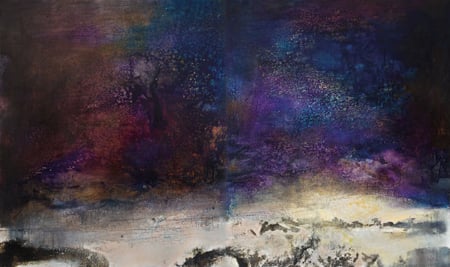
“Abstraction is somewhat misleading as a description of Zao’s paintings; it would be more accurate to say that their image field hovers between nature and abstraction, once in a while slipping over the edge into the reminiscence of a Chinese landscape schema.”1
The highest price paid for any work at international auction in April 2013 was for a sublime blue abstracted landscape oil painting by Contemporary artist Zao Wou-Ki (Chinese/French, 1921–2013), one of the greatest Chinese artists of the 20th and 21st century. This piece sold for US$4,775,519 premium at Sotheby’s Hong Kong on April 6, 2013. Although blue was one of Zao’s favorite colors, his blue paintings are very rare. The artist used this color to reference rivers and lakes in his works. Sadly, three days after this exciting sale, Zao passed away. In recent years, the demand for his paintings and lithographs on the primary and secondary market has begun to rise to an all time high among collectors in both the East and West.
Zao Wou-Ki, 10.03.83 (diptych), 1983, Sold for US$4,775,519 Premium at Sotheby’s Hong Kong on April 6, 2013
In order to understand the universal appeal as well as the legacy of Zao, one must examine the role that nature played in his decade’s long oeuvre, and his singular manner of conflating traditional Chinese landscape paintings with Western Abstract Expressionism. The artist’s paintings and prints are considered to be a major art historical development of both Western abstraction and Chinese landscape painting.
In 1948, Zao left China and moved to Paris, which became his new home for most of his life. Within a year, he was already exhibiting his works at galleries in the city, with his first solo show held at Galeris Creize in 1949. Zao became a French citizen in 1964 and was honored by the country for his contribution to the arts. He was appointed Officier de la Légion d’Honneur in 1984, progressing to Commandeur in 1993 and Grand Officier in 2006. During this time, the Paris School greatly influenced his work, and he completely rejected the traditional manners and materials of his formal training in the arts from China.
Zao took an extended visit to several European countries and New York in 1957, during which time he met and was influenced by Abstract Expressionist artists including Paul Klee (German/Swiss, 1879–1940), Franz Kline (American, 1910–1962), and Adolph Gottlieb (American, 1903–1974). By the 1970s, Zao had experimented with depictions of key elements of 16th-century Chinese landscape painting and Western Abstract Expressionism in single works. The artist created vivid Abstract landscapes using line, color, light, and shadow inspired by nature. Through his incorporation of Eastern and Western themes and materials, Zao was able to come to terms with the duality in his own life; he had left China, and traditional ink painting, years earlier. At this time, he discovered his love for creating prints, which have since become an important element of his oeuvre.
Zao Wou-Ki, Les Carnets de Voyages I,1950–2006, 798 MP, Paris, France
Zao’s career is defined by the singular manner in which he reinterpreted Eastern elements from 16th-century Sung and Yuan Dynasty landscape paintings. He expressed the essences of nature these works possessed while employing the Western medium of oil. The artist’s paintings and prints clearly avoid representation of forms from nature, expressing instead the Abstract feeling of the colors, reflections, energy, and harmony of land, sea, earth, and sky.
“How to represent the wind? How to paint emptiness? And the light, its brightness, its purity? I did not want to reproduce but to juxtapose forms, to assemble them in order to fing in them the whispering wind over still water.”2 -Zao Wou-Ki
1 Hay, Jonathan. 2003 Zao Wou-Ki: Recent Works, Marlborough Gallery, New York, NY, United States.
2 “Zao Wou-Ki,” Denis Bloch Fine Art, http://www.denisbloch.com/showall.php?id=14.